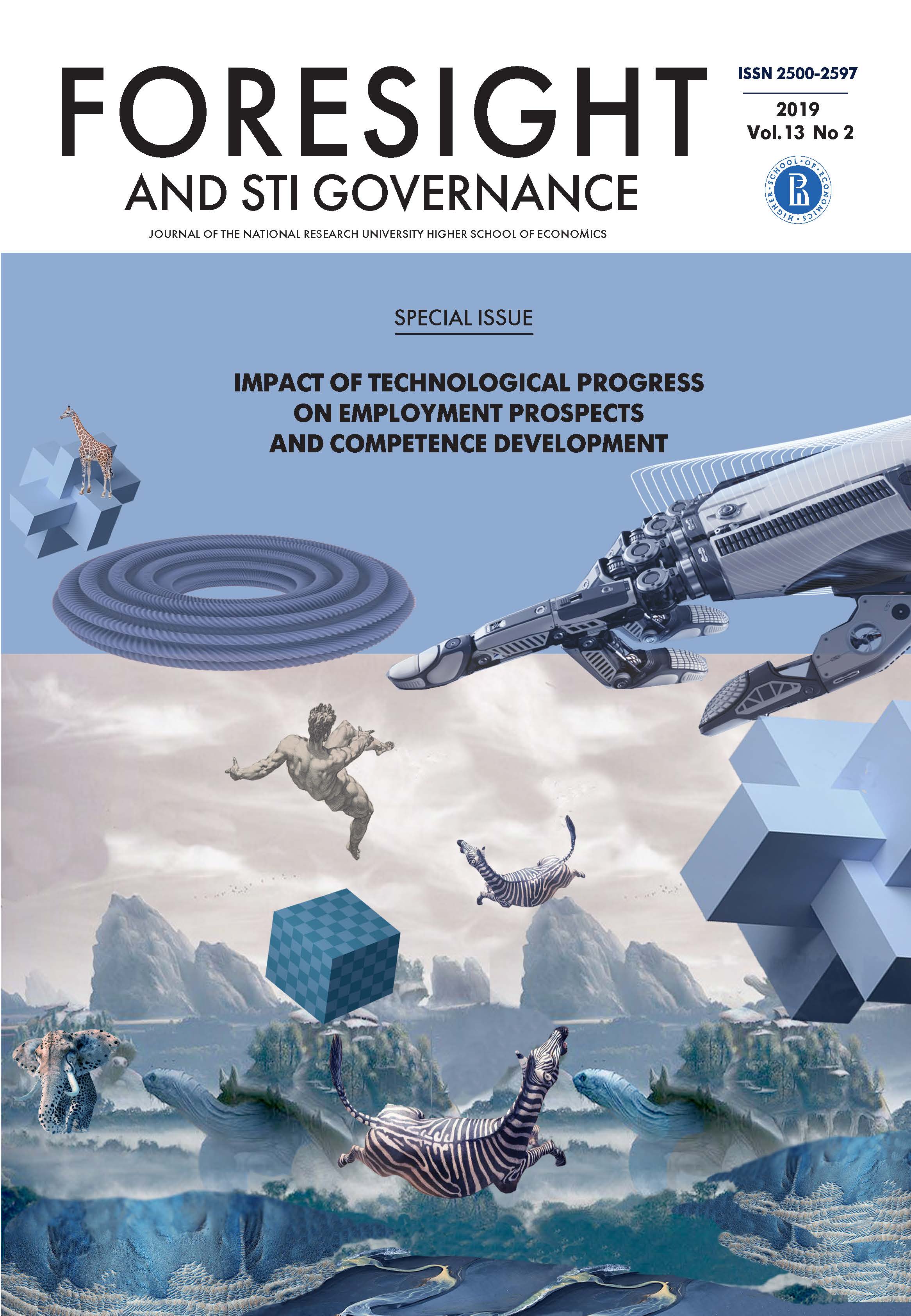Abstract
This paper analyzes the impact of breakthrough technological areas, such as artificial intelligence (AI), big data, the internet of things, and blockchain upon on conventional banking professions and skill sets. Our conclusions are based upon a large array of data collected over the course of a survey of top personnel conducted in 2017-2018 using text mining, case studies, and expert interviews. The changing requirements for workers and their competences were assessed taking into account the level of technological development (including use of relevant products and services by Russian and international companies) as well as the probability of certain professional skills being substituted by automated solutions in the medium term. The results indicate that technologies’ impact upon various functional segments of banks’ operations is varied. While most of the analyzed professions are evolving towards broader functionality, others are sliding into the “obsolete” group. In the next few years, automated systems will take full responsibility for data collection and its initial analysis, though they will not replace bank personnel fully given that they simply remain tools that help boost workers’ productivity and efficiency, extend the information base, accelerate decision-making, cut costs, and reduce risks.
References
Accenture (2018) Realizing the full value of AI in banking. Режим доступа: https://www.accenture.com/gb-en/insights/banking/future-workforce-banking-survey, дата обращения: 14.06.2018.
Ahmad B., Blaug M. (eds.) (1973) The Practice of Manpower Forecasting: A Collection of Case Studies. Amsterdam: Elsevier.
Anagnoste S. (2017) Robotic automation process - The next major revolution in terms of back office operations improvement // Proceedings of the International Conference on Business Excellence. Vol. 11. № 1. P. 676-686.
Arntz M., Gregory T., Zierahn U. (2016) The Risk of Automation for Jobs in OECD Countries: A Comparative Analysis. OECD Social, Employment and Migration Working Paper 189. Paris: OECD.
Arntz M., Gregory T., Zierahn U. (2017) Revisiting the risk of automation // Economics Letters. Vol. 159. P. 157-160.
BCG (2018) The Impact of Artificial Intelligence (AI) on the Financial Job Market. Boston, MA: Boston Consulting Group. Режим доступа: http://image-src.bcg.com/Images/BCG-CDRF-The-Impact-of-AI-on-the-Financial-Job-Market_Mar%202018_ENG_tcm9-187843.pdf, дата обращения 28.09.2018.
Bain&Company (2017) Evolving the Customer Experience in Banking. Режим доступа: http://www.bain.com/publications/articles/evolving-the-customer-experience-in-banking.aspx, дата обращения 14.11.2018.
Bakhtin P.D., Saritas O., Chulok A., Kuzminov I., Timofeev A. (2017) Trend Monitoring for Linking Science and Strategy // Scientometrics. Vol. 111. № 3. P. 2059-2075.
Bringsjord S., Govindarajulu N.S. (2018) Artificial Intelligence // The Stanford Encyclopedia of Philosophy (Fall 2018 Edition) / Ed. E.N. Zalta. Режим доступа: https://plato.stanford.edu/archives/fall2018/entries/artificial-intelligence/, дата обращения: 11.02.2019.
Brynjolfsson E., Mitchell T. (2017) What can machine learning do? Workforce implications // Science. № 358(6370). P. 1530-1534.
Colclough C. (1990) How can the manpower planning debate be resolved? // Quantitative Techniques in Employment Planning / Eds. R. Amjad, C. Colclough, N. Garcia, M. Hopkins, R. Infante, G. Rogers. Geneva: International Labour Office. P. 1-23.
David B. (2017) Computer technology and probable job destructions in Japan: An evaluation // Journal of the Japanese and International Economies. Vol. 43. P. 77-87.
El Achkar S. (2010) A Companion Guide to Analyzing and Projecting Occupational Trends. CSLS Research Report 2010-07. Ottawa: Centre for the Study of Living Standards.
Financial Brand (2018) Artificial Intelligence and The Banking Industry’s $1 Trillion Opportunity. Режим доступа: https://thefinancialbrand.com/72653/artificial-intelligence-trends-banking-industry/, дата обращения 14.11.2018.
Financial Times (2018) AI in banking: The reality behind the hype. Режим доступа: https://www.ft.com/content/b497a134-2d21-11e8-a34a-7e7563b0b0f4, дата обращения 24.11.2018.
Frey C.B., Osborne M.A. (2017) The future of employment: How susceptible are jobs to computerisation? // Technological Forecasting and Social Change. Vol. 114. P. 254-280. Режим доступа: https://www.sciencedirect.com/science/article/pii/S0040162516302244, дата обращения 04.06.2018.
Gokhberg L., Kuzminov I., Bakhtin P., Tochilina E., Chulok A., Timofeev A., Lavrynenko A. (2017) Big-Data-Augmented Approach to Emerging Technologies Identification: Case of Agriculture and Food Sector. HSE Working Paper WP BRP 76/STI/2017. Moscow: HSE.
Gunning D. (2017) Explainable artificial intelligence (xai). Arlington, VA: Defense Advanced Research Projects Agency (DARPA). Режим доступа: https://www.cc.gatech.edu/~alanwags/DLAI2016/(Gunning)%20IJCAI-16%20DLAI%20WS.pdf, дата обращения 15.02.2019.
Hopkins M. (2002) Labour market planning revisited. New York: Palgrave MacMillan. Режим доступа: , дата обращения 15.02.2019. DOI: https://doi.org/10.1057/9781403920263
Kim Y.J., Kim K., Lee S. (2017) The rise of technological unemployment and its implications on the future macroeconomic landscape // Futures. Vol. 87. P. 1-9.
Krugman P. (2003) Lumps of labor // The New York Times, 10.03.2003. Режим доступа: https://www.nytimes.com/2003/10/07/opinion/lumps-of-labor.html, дата обращения 15.02.2019.
McKinsey Global Institute (2017) A future that works: Automation, employment and productivity. New York: McKinsey Global Institute Режим доступа: https://www.mckinsey.com/~/media/mckinsey/featured%20insights/Digital%20Disruption/Harnessing%20automation%20for%20a%20future%20that%20works/MGI-A-future-that-works-Executive-summary.ashx, дата обращения 04.06.2018.
OECD (2017) OECD Employment Outlook 2017. Paris: OECD. Режим доступа: , дата обращения 04.06.2018. DOI: https://doi.org/10.1787/empl_outlook-2017-en
Psacharopoulos G. (1991) From manpower planning to labour market analysis // International Labour Review. Vol. 130. № 4. P. 459-474.
PwC (2018) PwC’s 2018 Digital Banking Consumer Survey: Mobile users set the agenda. London: PricewaterhouseCoopers. Режим доступа: https://www.pwc.com/us/en/financial-services/publications/assets/pwc-fsi-whitepaper-digital-banking-consumer-survey.pdf, дата обращения 14.06.2018.
Sala G. (2011) Approaches to skills mismatch in the labour market: A literature review // Papers: Revista de Sociologia. Vol. 96. № 4. Р. 1025-1045.
Sandberg A. (2010) An overview of models of technological singularity. Paper presented at the Roadmaps to AGI and the Future of AGI Workshop, Lugano, Switzerland, March. Режим доступа: http://agi-conf.org/2010/wp-content/uploads/2009/06/agi10singmodels2.pdf, дата обращения 15.06.2018.
Vivarelli M. (2007) Innovation and Employment: A Survey. IZA Discussion Paper 2621. Bonn: IZA.
WEF (2016) The Future of Jobs Employment, Skills and Workforce Strategy for the Fourth Industrial Revolution. Geneva: World Economic Forum. Режим доступа: http://www3.weforum.org/docs/WEF_FOJ_Executive_Summary_Jobs.pdf, дата обращения: 15.06.2018).
Walker T. (2007) Why economists dislike a lump of labor // Review of Social Economy. Vol. 65. № 3. P. 279-291.
Williems E. (1998) Interpreting Gaps in Manpower Forecasting Models // Labour. Vol. 12. № 4. P. 633-641. Режим доступа: , дата обращения 15.06.2018. DOI: https://doi.org/10.1111/1467-9914.00083
Wong J.M.W., Chan A.P.C., Chiang Y.H. (2004) A critical review of forecasting models to predict manpower demand // Australasian Journal of Construction Economics and Building. Vol. 4. № 2. P. 43-56.
World Bank (2006) Skill Development in India: The Vocational Education and Training System. Washington, D.C.: World Bank.
Капелюшников Р. (2017) Технологический прогресс - пожиратель рабочих мест? // Вопросы экономики. № 11. С. 70-101.

This work is licensed under a Creative Commons Attribution 4.0 International License.

